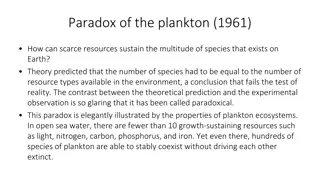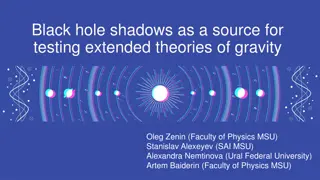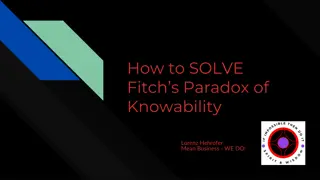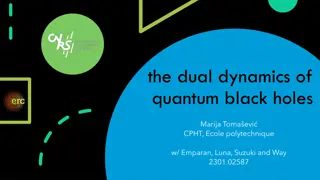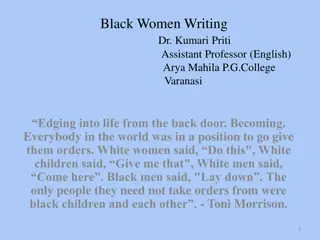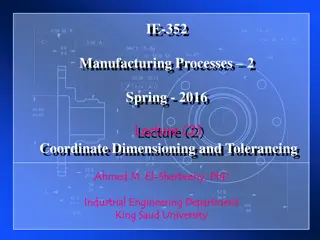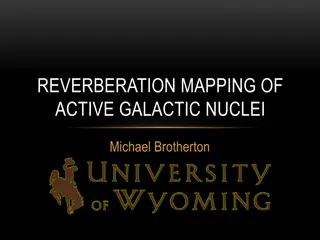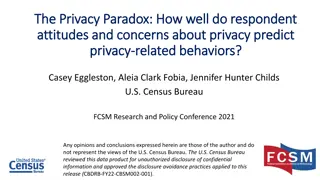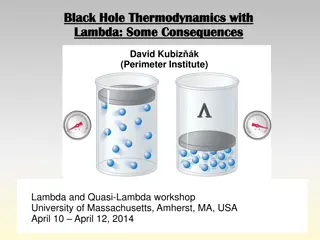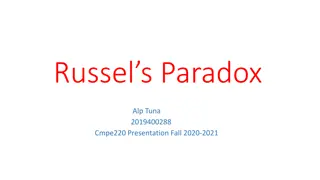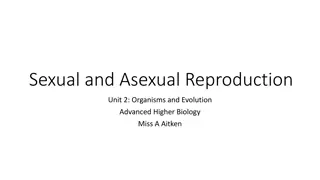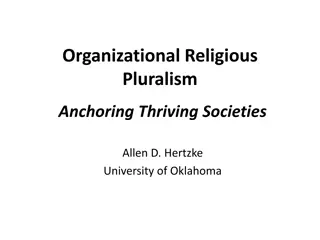The Black Hole Information Paradox
Explore the classical concepts of black holes in General Relativity, including the Schwarzschild Solution and the definition of black holes. Delve into quantum effects and the ongoing debate surrounding the Black Hole Information Paradox.
Download Presentation

Please find below an Image/Link to download the presentation.
The content on the website is provided AS IS for your information and personal use only. It may not be sold, licensed, or shared on other websites without obtaining consent from the author.If you encounter any issues during the download, it is possible that the publisher has removed the file from their server.
You are allowed to download the files provided on this website for personal or commercial use, subject to the condition that they are used lawfully. All files are the property of their respective owners.
The content on the website is provided AS IS for your information and personal use only. It may not be sold, licensed, or shared on other websites without obtaining consent from the author.
E N D
Presentation Transcript
Black Hole Information Paradox Adel Awad Centre for Theoretical Physics British University in Egypt
Outline I- Classical Black Holes 1- General Relativity 2- Schwarzschild Solution 3- What is a Black Hole 4- Do Black Holes Exist? 5- Laws of Black Hole Mechanics II- Quantum Effects and Black Holes 1- Quantum Calculation 2- Hawking s Argument 3- Black Hole Complementarity 4- Firewall Argument III- Conclusion
I- Classical Black Holes 1- General Relativity (GR) GR basic assumptions: a) Equivalence Principle geometrical description of gravity. b) Principle of General Covariance expressing physical laws in tensorial form. Field Equations: (geometry) R - 1/2 g R+ g = T , (matter) which is similar to Poisson's eqns. 2 = The fundamental quantity here is the metric g ds2 = g dx dx .
2- Schwarzschild Solution Solving vacuum Einstein's Eqns. with spherical symmetry, one obtains what is called Schwarzschild solution; ds2 = - (1-2m/r) dt2 + (1-2m/r)-1 dr2 + r2(d 2 +sin( )2 d 2 At rs= 2m something goes wrong, it is a horizon! It divides the space into r > 2m and r < 2m. If we squeeze the matter of a star till it goes inside rs? We get what is called a Black Hole! . Schwarzschild Curvature singularity Surf. of the star Surf. of the star horizon
3- What is a Black Hole Defintion: A black hole is a region in space which has very strong gravitational field such that a light ray emitted from its surface can not escape its gravitational pull. Simple classical argument: (Laplace 1798) black hole vesc= (2 G M/R)1/2 c = (2 G M/R)1/2 Hawking and Penrose were able to prove that singularities can occur generally in Einstein's G R. Theorem: The only measurable quantities for a BH are the mass, charge and angular momentum. Notice the analogy between a BH and an elementary particle.
Black Hole in other Coordinates Systems ds2 = - (1-2m/r) dt2 + (1-2m/r)-1 dr2 + r2(d 2 +sin( )2 d 2 Tortoise coordinates Eddington-Finkelstein coordinates
5- Laws of BH Mechanics After studying classical BH's for years relativists were able to write down the following laws; First Law: d M = K dA+ dq d U = T dS- PdV Second Law: d A 0 d S 0 Bekenstein in 1972 argued that the entropy of a BH S~ A 0. But can we interpret it as the statistical entropy of a BH? This is not consistent, since a thermal object must exchange radiations with its surrounding in order to maintain any thermal equilibrium.
II- Quantum Effects and Black Holes 1- A Quantum Calculation In 1975, Hawking showed that by quantizing matter fields and keeping gravity classical (semi-classical) a BH must radiates thermally due to quantum effects. BH horizon E field e - e + TH=1/8 GM e - e + Strong G field effect Strong E field effect
Later he argued that this radiation violates unitarity which shows that BH is losing information, this is known as "information loss paradox". M with large S Thermal radiation ? |out > = U |in > |in > = U+|out > The consequences are severe, either to modify QM or to show that the evolution is unitary. Let us try to understand Hawking s argument more clearly.
Quantum Mechanics in Nutshell Suppose we have a system with two energy levels: If the system in state | ,its energy is E1, with probability 1. If the system in state | ,its energy is E2, with probability 1. (Eigenstates) E1 | | E2 Physically the system can be in a state; a | + b | (superposition state) Then; you get energy is E1, with probability a2 and E2, with probability b2.
2- Hawkings Argument BH horizon Entangled state | pure | mixed | mixed = U| pure (U can not be unitary) Mixed | pure= | | A mixed state: A pure state: This radiation is seen by an observer who stays static w.r.t. BH. A free falling observer will not see any radiation!
3- Black Hole Complementarity Information has a precise meaning and accurate definition. Let us assume our system has two parts A (n d.f.) and B (m d.f.), S(A)=log(n), S(B)=log(m). Don Page calculated the time taken by a thermal system (BH) after which it starts to reveal information; t Page~ M3G2 Outside observer will detect entanglement between radiation and an earlier radiation, after this time. Therefore, in principle one can construct the initial pure state.
Black Hole Complementarity The above statement with the following assumptions is what we call BH complementarity picture: 1. Unitarity (information conservation) 2. Semi-classical approximation is adequate and we can apply QFT as long as R<< (Lp)-2. 3. Equivalence principle is valid (in-falling observer see no radiation)
Black Hole Complementarity outside observer Matter fall then thermalizes BH Both observers will not see any violation of laws of physics In-falling observer sees nothing unusual and no radiation or drama
Complementarity Argument earlier radiation before tpage Hawking s pair BH ( after tpage )
4- Firewall Argument Firewall argument (AMPS): a simple argument which states that the previous three assumptions of BH complementarity are not consistent (we have to give up on one of them) Monogamy of entanglement: an important property for all quantum systems which insure that any of two maximally entangled particles cannot be entangled with a third one. earlier radiation before tp Hawking s pair BH ( entangled ) ( entangled )
III- Conclusion BH information paradox is back! Of course not as strong as before, since we have gained new incite. One of the three natural assumptions is wrong. It is not clear what to choose but for AMPS people they choose 2 or 3. The firewall region could be a result of many things among them nonlocal QFT effects and/or trans-Planckian physics stretched up to the horizon. We need to rethink the relation between QM and GR.
3- Holographic Principle Hawking also found that BH entropy is proportional to the area of the horizon S = 1/4 Ah Using the above results, Bekenstein argued that the maximum entropy in a region of a space, with a boundary area A. S = 1/4 A This implies that in gravity the number of degrees of freedom grows as the area, A of the region. In contrast, in QFT S V. Can we describe a gravity theory using QFT in one dimension less ? During 1992-94 t'Hooft and Susskind argued that a quantum gravity theory can be described using a quantum field theory in one dimension less "holographic principle''.
AdS/CFT Correspondence The statement: (Maldacena 1997) A gravity theory on anti-de- Sitter (AdS ) space is equivalent to a conformal field theory (CFT or QFT) on the boundary of such a space. Through this we understood the following: Gravity-side QFT-side Gas of particles on AdS (for T < 1/L) gauge theory (confined) ( pure SU(N) SYM at T) gauge theory (deconfined) ( pure SU(N) SYM at T) BH on AdS (for T >1/L) If this duality is correct it would resolve the long standing paradox, but we need to test it.




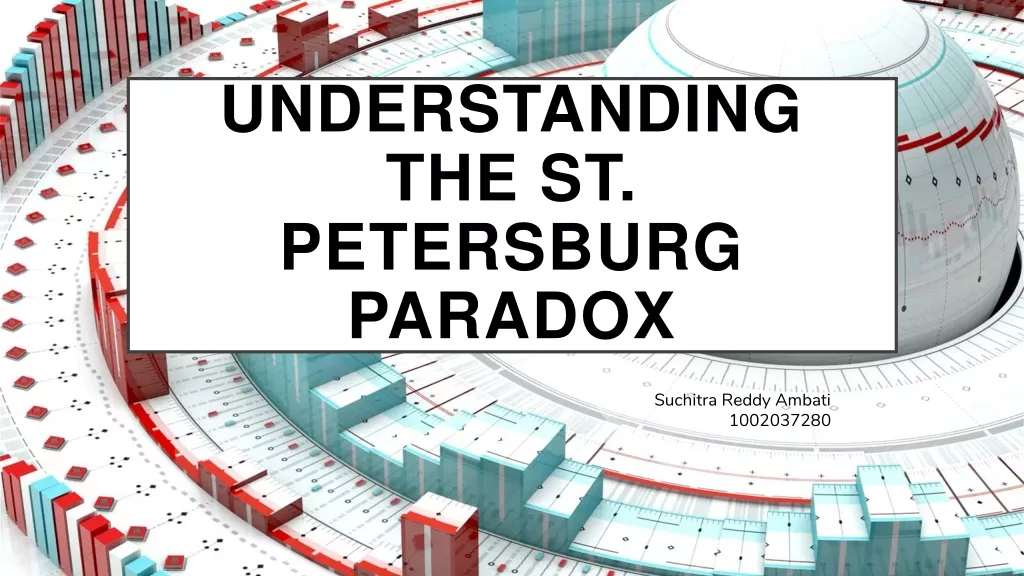
![[PDF⚡READ❤ONLINE] Black Hole Astrophysics: The Engine Paradigm (Springer Praxis](/thumb/21503/pdf-read-online-black-hole-astrophysics-the-engine-paradigm-springer-praxis.jpg)

